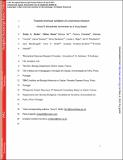Towards chemical validation of Leishmania infantum ribose 5-phosphate isomerase as a drug target
Abstract
Neglected tropical diseases caused by kinetoplastid parasites (Trypanosoma brucei, Trypanosoma cruzi and Leishmania spp.) place a significant health and economic burden on developing nations worldwide. Current therapies are largely out-dated, inadequate and facing mounting drug resistance from the causative parasites. Thus, there is an urgent need for drug discovery and development. Target-led drug discovery approaches have focused on the identification of parasite enzymes catalysing essential biochemical processes, which significantly differ from equivalent proteins found in humans, thereby providing potentially exploitable therapeutic windows. One such target is ribose 5-phosphate isomerase B (RpiB), an enzyme involved in the non-oxidative branch of the pentose phosphate pathway, which catalyses the inter-conversion of D-ribose 5-phosphate and D-ribulose 5-phosphate. Although protozoan RpiB has been the focus of numerous targeted studies, compounds capable of selectively inhibiting this parasite enzyme have not been identified. Here, we present the results of a fragment library screening against Leishmania infantum RpiB, performed using thermal shift analysis. Hit fragments were shown to be effective inhibitors of LiRpiB in activity assays, and several were capable of selectively inhibiting parasite growth in vitro. These results support the identification of LiRpiB as a validated therapeutic target. The X-ray crystal structure of apo LiRpiB was also solved, permitting docking studies to assess how hit fragments might interact with LiRpiB to inhibit its activity. Overall, this work will guide structure-based development of LiRpiB inhibitors as anti-leishmanial agents.
Citation
Dickie , E A , Ronin , C , Sá , M , Ciesielski , F , Trouche , N , Tavares , J , Santarem , N , Major , L L , Pemberton , I K , MacDougall , J , Smith , T K , Cordeiro-da-Silva , A & Ciapetti , P 2021 , ' Towards chemical validation of Leishmania infantum ribose 5-phosphate isomerase as a drug target ' , Antimicrobial Agents and Chemotherapy , vol. Early . https://doi.org/10.1128/AAC.01892-20
Publication
Antimicrobial Agents and Chemotherapy
Status
Peer reviewed
ISSN
0066-4804Type
Journal article
Description
Funding from the European Community's Seventh Framework Programme under grant agreements No. 602773 (Project KINDRED) was received for all partners in this work. This work also received funds from FCT - Fundação para a Ciência e a Tecnologia/Ministério da Ciência, Tecnologia e Ensino Superior through the Research Unit No. 4293 and project POCI-01-0145-FEDER-031013 (PTDC/SAUPAR/31013/2017 to NS); Individual funding from FCT through SFRH/BD/133485/2017 (to MS) and CEECIND/02362/2017 (to JT).Collections
Items in the St Andrews Research Repository are protected by copyright, with all rights reserved, unless otherwise indicated.

